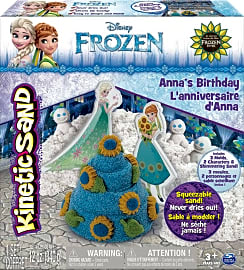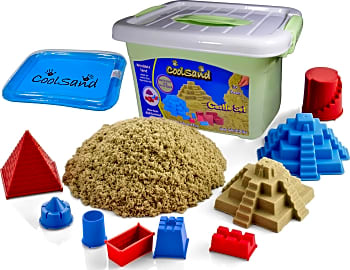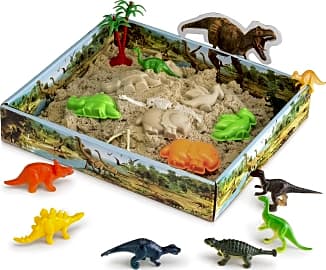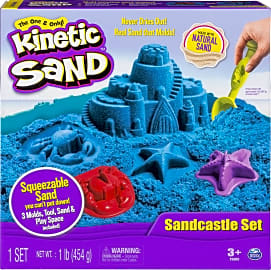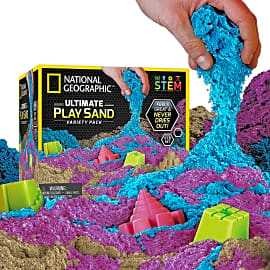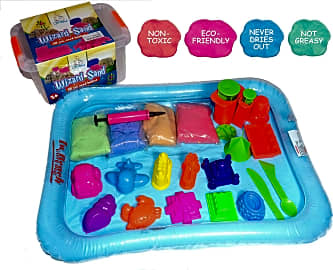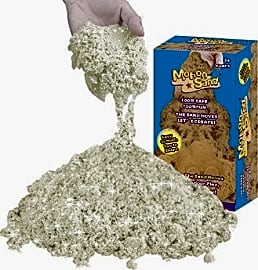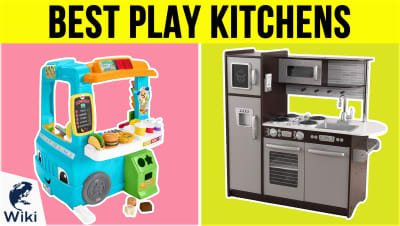The 8 Best Kinetic Sand Sets

This wiki has been updated 39 times since it was first published in March of 2017. Most parents and educators agree that an ideal toy is one that sparks a youngster's imagination by providing open-ended play opportunities. These kinetic sand sets offer limitless ways for children to express their creativity, and are suitable for use by kids big and small. For a safe playtime, always supervise little ones, and adhere to manufacturers' stated age guidelines. When users buy our independently chosen editorial recommendations, we may earn commissions to help fund the Wiki.
Editor's Notes
October 24, 2019:
Like a tried-and-true Play Doh set, a colorful kinetic sand kit can provide your child with hours of hands-on fun creating and recreating their favorite things. They typically feature an array of molds and tools for rolling, cutting, and shaping the finished product. The beauty of this material is while it sticks to itself, it won’t stick to your hands or other surfaces. This is because it’s made from 98% sand and 2% silicon. It’s sold in a full range of colors – including some shimmery ones as well as glow-in-the-dark options. Our selection features kits in a variety of themes, as well as a standalone bag of sand that would make for a nice supplement to a separate, full-featured kit that’s running low on sand.
Joining the list in today’s update is the Kinetic Sand Bake Shoppe, which comes with sand in pink and yellow, which can be mixed to form a third color of orange. You’ll get all of the tools needed to create colorful, pretend cupcakes and cookies. This includes stampers, a spatula, and a rolling pin that doubles as a storage compartment. Once your creations are formed and decorated, you can proudly display them on the included tray. Note that similarly priced sets in different themes are also available from the manufacturer, including “Dig & Demolish,” “Castle Containers,” and “Beach Day Fun.”
Another new addition is the National Geographic Play Pack, a toy that’s sure to be as educational as it is fun. It comes with multiple pounds of sand in a variety of colors and the molds to make likenesses of the following historic structures: Great Pyramid of Giza, Chichén Itzá, Shwedagon Pagoda, Great Mosque of Samarra, Citadel of Aleppo, and Taj Mahal. While this sand is smoother and softer than that of many other products, note that it can stain your hands rather easily.
The third new addition is the CoolSand Dino Discovery, which any dinosaur-lover is sure to get excited about. It comes with 10 colorful molds that feature friendly-looking dinosaur friends, as well as 12 small plastic figures modeled after a pterodactyl, a stegosaurus, and more. What’s more, it also comes with 7 toy fossils that aspiring paleontologists will love to excavate from the sand. The packaging doubles as a sandbox, but be sure to treat it with care to ensure it’ll hold up for another playtime.
Leaving the list at this time, due to availability issues, are the Dino Dig Fossils, Polly Sand, and Doggy Daycare.
How Does Kinetic Sand Work?
The length of the polymer chain affects its viscoelasticity, which is the term describing its ability to transform from one physical state to another.
If you've ever played with kinetic sand, then you know there's nothing quite like it — it's like being on a beach made of Play-Doh. You can build with it, slice it up, and make incredible sculptures out of it, all without making a mess. But how does it work?
Short answer: witchcraft: Long answer: science.
Kinetic sand is actually just regular old sand that's been coated in silicone oil. These same oils are used in everything from cosmetics to sealants because they're capable of switching physical states easily. They can be liquids, a plasma that moves slowly, or rubbery solids, depending on the environment in which they're placed.
To understand why this happens, we're going to have to dig deep into silicone oil's molecular structure, and we're going to need to use words we don't fully understand, like "polymer" and "viscoelasticity."
Silicone isn't a single thing, but rather a family of materials that includes anything that combines silicon and oxygen. These materials are polymers, meaning they're made of long chains of similar units bonded together.
The length of the polymer chain affects its viscoelasticity, which is the term describing its ability to transform from one physical state to another. The longer the chain, the more resistant it becomes to flowing freely.
The polymer chains within the silicone oil are long enough to bond the sand particles together, but short enough that the sand moves relatively easily under pressure.
However, the best thing about this particular polymer chain is that the particles in the oil and sand only stick to each other, not any other surface they come in contact with. That's why it's easy to clean up when you're done playing with it.
Other Ways To Get Kids Interested In Science
Kids and science are a fickle mixture. Sometimes they're fascinated by it, other times they can't be bothered to look up from their phones long enough to care. So, how do you get them to spend more time caring about science?
First off, don't force it on them. If you try to shove it down their throats, they'll definitely lose interest — and you might never be able to get that interest back. Let them come to it on their own terms, in their own time.
If you come down hard on them every time they come home with an A- on their report card, they'll surely start to hate the subject.
Also, don't frame it as a "love it or hate it" decision. Make sure they realize that if a particular subject doesn't interest them, that doesn't mean that all of science is equally uninteresting. Do the same thing with their aptitude — just because they struggle with chemistry doesn't mean that they're bad at science, it just means that they struggle with chemistry. Biology might still be right up their alley.
You'll need to be ready for the, "When will I actually use this stuff?" question, too. The best way to do this is to make every subject applicable to daily life, so that they can see all the ways in which science affects their life.
If you can match this to things they're already interested in, it will be even more likely to stick. If they're into video games, maybe introduce them to coding. If they like to cook, demonstrate how chemistry affects the way ingredients react to different stimuli.
Don't keep your nose stuck in a book, either. Try to find ways to make learning hands-on, whether that means going to museums or doing experiments at home (just make sure no one ends up at the ER — that's a great way to ruin science for life).
Finally, don't make it too high-stakes. If you come down hard on them every time they come home with an A- on their report card, they'll surely start to hate the subject. Rather, praise them for their good work, and take an interest in their activities.
After all, if you can get your kid interested in science, it will give you a ready-made fall guy for when you accidentally blow your house up doing one of those experiments.
Finding Toys That Won't Cause A Mess
Buying your kid a toy is a double-edged sword: sure, it keeps the little rugrats quiet and out of your hair for awhile, but it also inevitably causes a mess (especially if you give them a double-edged sword).
Books are just about the best gift you can give a child. Not only do they expand their minds and engage their imaginations, but books hardly make a mess — and it doesn't hurt if you step on one.
Give them positive reinforcement, and be realistic in your expectations.
Anything that keeps them (and their clutter) in one place is a smart choice, too. This could include a play kitchen, a slide, or some sort of riding toy. Just make sure they know that they have to limit their play to the general vicinity of the toy.
Ultimately, though, the best way to deal with toy clutter is to teach your kid to put things away when they're done. Try to make it easy — give them their own organizer, for example — so that it's not a huge hassle, because if it's too hard they'll never do it.
You can make cleaning up a condition of playing with a favorite toy — they don't get it unless they put it away when they're done. Or you can reward them with something else when they're done tidying up.
Give them positive reinforcement, and be realistic in your expectations. A spotless floor might be a pipe dream, but you can probably get them to corral most of their mess and confine it to a corner.
Except for that single Lego that you'll find the hard way when you have to get up in the middle of the night.


